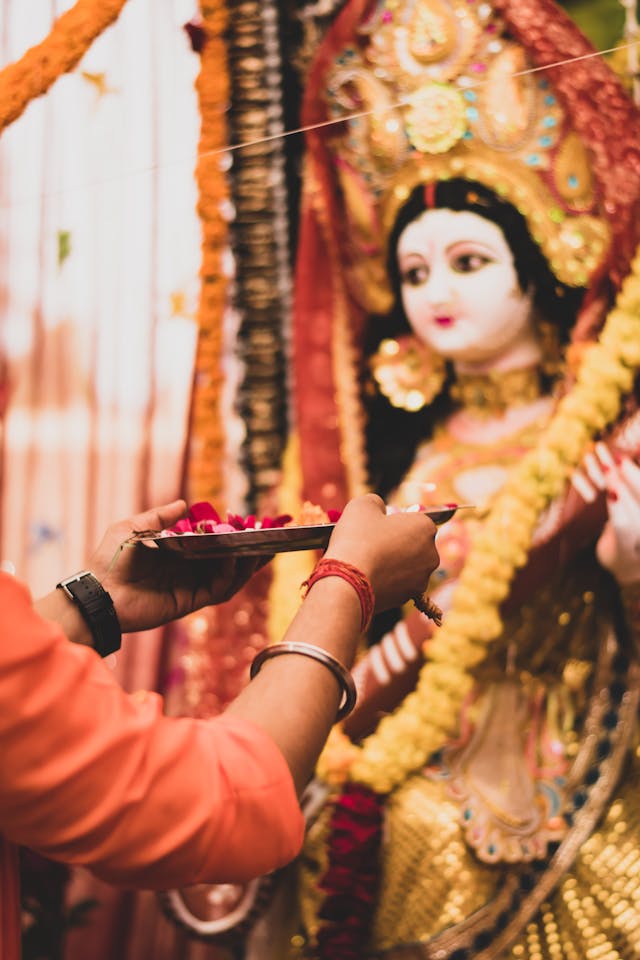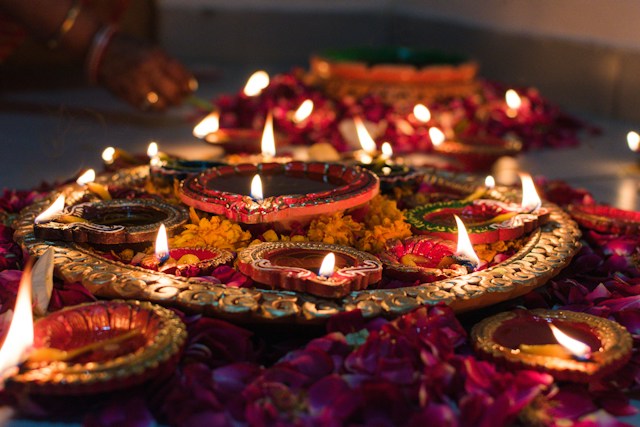I’ve had the unique opportunity to witness the vibrant celebration of Durga Puja, especially in the North East. This festival not only illuminates the region with its spiritual fervor but also offers a gastronomic feast that is unparalleled. Through my travels and tastings, I’ve gathered insights and experiences, some of which were profoundly personal, into the culinary traditions that define this auspicious time.
Traditional Bengali Dishes
The essence of Durga Puja transcends beyond mere religious observance; it’s a time when culinary traditions are revered and shared with enthusiasm. One cannot speak of Durga Puja without mentioning the quintessential Bhog, offered to the deity and later distributed among devotees. This prasad typically includes Khichuri, Labra (a mixed vegetable dish), and a variety of Bhaja (fried vegetables), embodying the simplicity and warmth of Bengali hospitality. My personal experience savoring Bhog among locals in a community pandal was a testament to the communal spirit and culinary heritage that Durga Puja celebrates. Additionally, sweets such as Sandesh and Rosogolla are not just treats but a means of sharing joy. Visiting sweet shops in Kolkata, I was amazed by the creativity and dedication of confectioners during this season, introducing innovative flavors while preserving traditional tastes.
Local Delicacies of the North East
Beyond traditional Bengali cuisine, the North East offers a plethora of local delicacies during Durga Puja, reflecting the region’s diverse culinary landscape. Each state, from Assam to Meghalaya, brings its unique flavors to the fore. For instance, in Assam, the festival is an opportunity to relish Pitha (rice cakes) and Laru (traditional sweets), made with meticulous care in households. My journey through these states allowed me to appreciate the subtleties of regional cuisines, such as the use of bamboo shoot in Meghalayan dishes or the distinctive flavors of Manipuri Eromba. These culinary experiences are not just about tasting; they’re about understanding the cultural nuances and local ingredients that define this region’s food culture. The hospitality of the locals, inviting me into their homes to share a meal, was a warm reminder of the universal language of food.
Street Food and Pandals
No exploration of Durga Puja’s culinary delights is complete without delving into the vibrant world of street food and pandal hopping. The streets of North East India, particularly in urban centers, come alive with makeshift stalls offering everything from Jhalmuri to Kolkata’s famous Kathi rolls. The experience of navigating through bustling pandal lanes, with the aroma of freshly prepared delicacies wafting through the air, is exhilarating. One of my most cherished memories involves savoring Phuchka (pani puri) by the lakeside in Agartala, a moment that encapsulated the joyous spirit of the festival. It’s in these spontaneous culinary explorations that one truly experiences the essence of Durga Puja.
Must-try Traditional Bengali Dishes

- Bhog Khichuri: A hearty, fragrant mix of rice and lentils, seasoned with spices and often accompanied by mixed vegetables.
- Labra: A traditional mixed vegetable dish that is a staple part of the Durga Puja bhog.
- Sweets like Sandesh and Rosogolla: These epitomize Bengali confectionery craftsmanship, with their delicate flavors and textures.
Exploring Local Delicacies
– Pitha and Laru from Assam: These rice-based sweets and cakes are essential to Assamese festivities. – Bamboo Shoot Dishes from Meghalaya: Offering a unique taste that’s both earthy and refreshing. – Manipuri Eromba: A comforting dish made with boiled vegetables and fermented fish, showcasing the region’s love for simple, flavorful meals.
The Street Food Experience
- Kathi Rolls and Phuchka: Kolkata’s street food scene is vibrant, with these dishes standing out for their flavors and accessibility.
- Pandals and Street Vendors: They offer an immersive way to enjoy Durga Puja’s culinary diversity, from traditional sweets to savory snacks.
In my travels and experiences I’ve found that food is much more than sustenance. It’s a celebration of culture, a testament to the region’s diversity, and a bridge that connects us all. Whether it was the simple yet profound flavors of the bhog, the innovative sweets in Kolkata’s bylanes, or the unique local delicacies of each state, every meal was a journey into the heart of Durga Puja’s culinary traditions. For foodies and culture enthusiasts alike, exploring these gastronomic delights offers a rich, sensory experience that goes beyond the plate, into the essence of what makes Durga Puja so special. This exploration is not just about tasting food; it’s about experiencing the warmth, joy, and communal spirit that defines this festive season.





